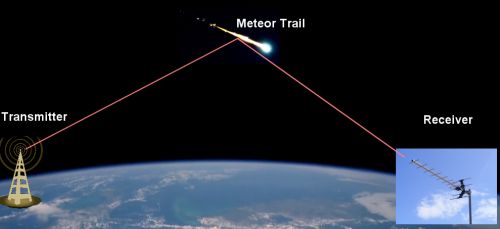When the big annual meteor showers come around, you can often find us driving up to a mountaintop to escape light pollution and watching the skies for a while. But what to do when it’s cloudy? Or when you’re just too lazy to leave your computer monitor? One solution is to listen to meteors online! (Yeah, it’s not the same.)
Meteors leave a trail of ionized gas in their wake. That’s what you see when you’re watching the “shooting stars”. Besides glowing, this gas also reflects radio waves, so you could in principle listen for reflections of terrestrial broadcasts that bounce off of the meteors’ tails. This is the basis of the meteor burst communication mode.
[Ciprian Sufitchi, N2YO] set up his system using nothing more than a cheap RTL-SDR dongle and a Yagi antenna, which he describes in his writeup (PDF) on meteor echoes. The trick is to find a strong signal broadcast from the earth that’s in the 40-70 MHz region where the atmosphere is most transparent so that you get a good signal.
This used to be easy, because analog TV stations would put out hundreds of kilowatts in these bands. Now, with the transition to digital TV, things are a lot quieter. But there are still a few hold-outs. If you’re in the eastern half of the USA, for instance, there’s a transmitter in Ontario, Canada that’s still broadcasting analog on channel 2. Simply point your antenna at Ontario, aim it up into the ionosphere, and you’re all set.
We’re interested in anyone in Europe knows of similar powerful emitters in these bands.
As you’d expect, we’ve covered meteor burst before, but the ease of installation provided by the SDR + Yagi solution is ridiculous. And speaking of ridiculous, how about communicating by bouncing signals off of passing airplanes? What will those ham radio folks think of next?
















Um, you know Ontario is bigger than Texas so you need to give a bit more accurate co-ordinates.
Or you could simply spend 25 seconds using a search engine:
https://en.wikipedia.org/wiki/CHBX-TV
You nailed that one!
What, and take time away from my trolling!?
There is also the Graves radar in France that many in Europe use as the transmitter for meteor radio reflections as well.
It’s amusing to say the least when listening to Coast to Coast AM and the subject is meteor impacts that the reception will suddenly switch to another signal and I will say “there’s one now”!
I listen on FM from 60mi. away so anything stronger takes over for a shot or a longer lingering taste of somewhere else.
Nice link to the online live meteor thing! Listened for about 2 minutes and then heard a ping lasting 2 seconds or so!
Stewart Brand tells of the weather station they placed at the location of the Long Now Clock while planning it: It was (maybe still is) solar powered, and transmitted weather reports by bouncing off meteor trails to a receiver in Bozeman.
Well, the UK has the 4m amateur band, and there is the 6m amateur band worldwide. Would your regular beacons work as things to listen for bounced off meteorites?
While they aren’t high powered broadcasters. Amateur Radio VHF contesters live for predictable regular Meteor showers, that that would be activity yo listen for no matter where tou live. Practice up with your Morse code.
The military made efforts to use ‘meteor bounce’ as a communication mechanism. The stations involved would listen for a path between them to open and then burst their data when it did. The opportunities came along surprisibgly often.
I recall this as a project in “The Scientific Book of Projects for the Amateur Scientist” from 1960 along with a lightning strike detector or counter – “spherics counter” if I recall. The book was in my high school library and practically memorized it.
There is a VHF transmitter installed in Belgium dedicated to the study of meteroids. It is accompanied by a network of receiving stations spread out of the country. It is called ‘BRAMS’ (Belgian RAdio Meteor Stations). More info here: http://brams.aeronomie.be
Transmitter is 150 W at 49.97 MHz.
We have a ‘listener’ setup in the shack of our radio club with a simple yagi pointing towards the sky.
There still are analog tv transmitters in russia and eastern europe.
We use the 49.750MHz one in St. Petersburg, Russia the most.
Right under 6meters and powerful.
These links should have relatively up to date info:
http://www.g0che.co.uk/tv_info.php
http://dx.3sdesign.de/Band1-Offsets.htm
Low-VHF tv stations are also nice 6m beacons.
http://www.amateurradio.com/russian-tv-6ms-little-helpers/
Why do most signals sound like 1KHz tones but occasionally there are some higher frequency tones; and I also heard a couple of fairly loud signals that swept in frequency, like a chirp? What causes the frequency to change?